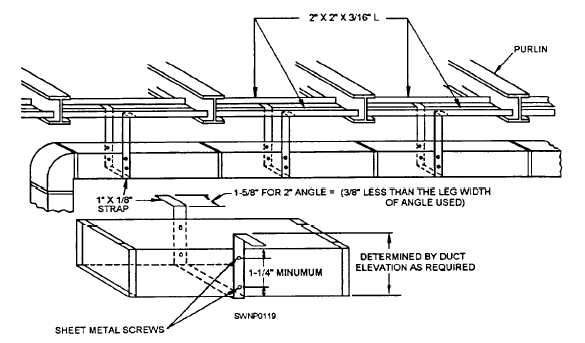degrees onto the flange of the beam or purlin. Again, the standard 7 feet 10 inches maximum span required between hangers applies. Also, the hanger screws standard will apply. The hanger span may be shortened to fit the job requirements.
For heavier or larger systems, an installation similar to that shown in figure 2-102 maybe required. This system is hung entirely on angle rails and the straps are fabricated into one-piece units. This system is by far the neatest looking and is normally used when the duct system is exposed.
Installing a duct system under a built-up steel roof (fig. 2-103) is accomplished by hanging the duct system with all-thread bolts and 2-inch by 2-inch by 1/8-inch angles. The all-thread bolt protrudes through the steel decking and is bolted from the top with a large washer and bolt, which extends down alongside the duct into the 2-inch by 2-inch angles which is also bolted from under the angle. This system allows for adjustment of height. Also notice that the all-the ad bolt extends into the top flat of the apex of the steel roof decking. This is required because connecting the all-thread bolt to the bottom valley of the steel deck will reduce the structural strength of the decking and may also cause water leaks.
FIBER-GLASS DUCT
SYSTEMS Throughout the Naval Construction Force (NCF) fiber-glass duct is becoming common on jobsites. It has the advantage of added insulating value, ease of fabrication and handling, as well as installation, and making it useful where traffic and handling/abuse are restricted.
DUCT CHARACTERISTICS
Fiber-glass ducts are manufactured of molded fiber-glass sheets covered with a thin film coating of aluminum, although thin vinyl or plastic coatings are sometimes used. In the NCF, we are primarily concerned with aluminum coated duct. Because it is fabricated of glass fibers, it is inherently insulated; therefore, it is used where insulation is a requirement.
Fiber-glass ducts can be molded into various shapes for special applications. The desired shapes can be ordered from the manufacturer's stock In the NCF, for all but special purposes, the duct is supplied in the flat form of a board that has V grooves cut into the inner surfaces to allow folding to fabricate rectangular sections (fig. 2-104, view A). The ends of the board is molded so when a rectangular/square duct is formed two sections of the same size will fit together in a shiplap joint (fig. 2-104, view C). This joint ensures a tight connection coupled with a positive alignment.

Figure 2-102. - Duct system with strap hangers from angle rails transverse to purlti
Continue Reading